Tips To Improve Indoor Air Quality
Here Are Some Tips To Help Keep Your “Home Sweet Home” A Healthy One For You And Your Family.
Vacuum, Vacuum, Vacuum
This cannot be stressed enough. You should vacuum at least twice a week, more often if you have pets. Vacuuming helps rid your carpet of dust, dust mite feces, animal hair and dander, human hair and dead skin, mold spores, dead bugs, abrasive sand and soil that shortens a carpets life. Make sure that you use a vacuum cleaner that has a high efficiency HEPA filtering system.
Dust mites love their home and no big, bad, ugly vacuum cleaner is going to stop them from clinging to carpets. Sad to say, vacuuming doesn’t remove mites. It does, however, help remove their dead bodies (which can’t cling) and fecal pellets as well as some dust-mite foods such as skin flakes, hair, pet dander, etc. Selecting the proper vacuum is of utmost importance. Look for models with tight connections to prevent allergens from blowing out and built-in HEPA filters, which are designed to absorb and contain up to 99.97 percent of airborne contaminants as small as 0.3 micron. HEPA vacuum cleaners are more expensive, but inexpensive vacuums often have porous bags and loose connections, allowing allergens to escape. If possible the best bet is to install a central vacuum system with the collection bag and motor in the garage. A vacuum cleaner with a high efficiency filtration bag removes soils and bio-contaminants from carpet and upholstery reducing the release of respirable particles into the air. These bags are now available for most models of vacuum cleaners at retail stores that carry vacuum cleaners and accessories. If you need suggestions for choosing a new vacuum or yours needs repaired visit or call one of the Service All Vacuum locations in Fort Wayne:
- 3211 E State Blvd 46805 260-483-8421
- 1029 East Dupont Road 46845 260-482-2258
- 5956 W Jefferson Blvd 46804 260-387-8767
You can also learn more by review a list of certified vacuums that received the seal of approval from The Carpet & Rug Institute (CRI).
If cleaning hard surface flooring, do not sweep because the allergens will be redistributed into the air and remain airborne. Instead vacuum the floors followed by a damp mop to keep the air your family breathes cleaner.
Adopt A “No Shoes” Policy Inside Your Home
Many cultures around the world do this to prevent outside grime and pollutants from entering their tidy homes via the bottom of someone’s shoe.
Taking your shoes off may help reduce the number of allergens entering the home. Your carpet will not wear out as soon and it will stay cleaner longer.
Clean Your Air Ducts
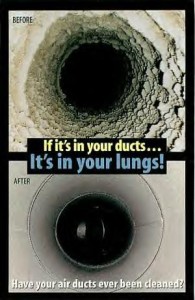 The air conditioning and heating system in your home collects and circulates contaminants throughout your home contributing to indoor allergies. Reducing the amount of the allergens circulating through your ventilation system can help to improve the indoor air quality of your home.
The air conditioning and heating system in your home collects and circulates contaminants throughout your home contributing to indoor allergies. Reducing the amount of the allergens circulating through your ventilation system can help to improve the indoor air quality of your home.
Air duct cleaning even makes sense to extend the life and maximize efficiency of your HVAC system. A build up of 0.42 inches of dirt on a heating or cooling coil can result in a decrease in efficiency of 21%. In addition 9 out of 10 heating, ventilating, air conditioning systems failures are caused by dust and dirt.
Read Angie’s List Article on “Is Air Duct Cleaning Worth It?”
Watch Angie’s List consumer awareness video on tips to find the air duct cleaning company.
On average the typical homeowner should have the air ducts in their home cleaned at least every 5-10 years to help eliminate allergens from being distributed throughout the home. There are some factors involved that would indicate more frequent cleanings such as allergy sufferers in the home, when you move into a new or used home, after remodeling or renovation, if your pet frequently sheds, moving into a previously occupied residence with smokers, after spring cleaning when dust is kicked up.
If you need your air ducts cleaned in Fort Wayne call Quality Air Duct Cleaning at 260-402-2692 or visit www.facebook.com/QualityAirDuctCleaningService
Avoid Smoke And Combustion Products
Smoke is a major asthma trigger so do not allow smoking in your home or car. Avoid burning candles as they release smoke, soot, and small amounts of chemicals into the air. If you do burn candles make sure the wicks are short. Burning a long wick can result in a larger flame and produce more soot. Avoid using scented or slow burning candles because they may contain additional additives. Wood-burning stoves and fireplaces also can be a source of smoke that trigger asthma or allergy symptoms. Avoid using a wood-burning stove or fireplace. Make sure it is airtight if you do use one. If you must use a wood burning stove or fireplace, use dried or cured wood instead of pressure-treated wood because fewer fumes are given off. The optimal heating system for someone with allergies or asthma would limit exposure to the by-products of burning wood or fossil fuels. Heat pumps, electric baseboard heaters, geothermal heating, or sealed combustion heating are good examples. Do not allow smoking in the house. Other fuel-burning appliances, like gas ranges, oil furnaces, water heaters, and space heaters, release combustion by-products that can pollute indoor air significantly and trigger asthma symptoms in some people. Have these appliances inspected and maintained regularly to identify leaks or damage. Back drafting (downward air flow in a chimney) can allow soot or smoke to enter the living space. Ask a chimney specialist to check the air pressure inside and outside the chimney to prevent back drafting. It’s a good idea to have your chimney or flue cleaned and inspected regularly.
For dryer vent & chimney inspection, cleaning, repair, and installation in Fort Wayne call:
- Dusty Brothers at 260-482-9991 or visit www.dustybrothers.com
- Chimney 1 at 260-489-2277 or visit www.chimney1.com
- Naylor & Sons at 260-436-2792 or visit www.naylorandsonsinc.com
Clean Your Mattress
 Imagine getting a good night’s sleep tonight! On average we spend about one-third of our time in bed. Keeping your sleeping area clean and allergen free is essential for your health.
Imagine getting a good night’s sleep tonight! On average we spend about one-third of our time in bed. Keeping your sleeping area clean and allergen free is essential for your health.
According to a study published by The National Institute of Environmental Health, 46 percent of North American homes have bedding with enough dust mite allergens to cause allergies. For allergy sufferers, the bedroom is the primary source of dust mite exposure in the home. About 60 percent of mites in the home are found in the mattress, as we spend one third of our life in bed – shedding skin and feeding dust mites. According to the Center for Disease Control, a mattress can have from 10,000 to 10,000,000 dust mites in it.
 Referral can professionally cleans mattresses. First the mattress is vacuumed with a truck mount so the allergens are vented outside. Then we wet-clean the top and sides of the mattress. The fabric is not overwet and an air mover is used to accelerate the dry time.
Referral can professionally cleans mattresses. First the mattress is vacuumed with a truck mount so the allergens are vented outside. Then we wet-clean the top and sides of the mattress. The fabric is not overwet and an air mover is used to accelerate the dry time.
To Effectively Control Dust Mite Allergens From Mattresses:
- The mattress should be regularly cleaned, about every 6 months for allergy sufferers.
- Wash bedding weekly in hot water and dry in a hot dryer.
- Cover mattresses, box springs and pillows in airtight, zippered plastic or allergen proof fabric covers.
- Replace your pillow. An old pillow can contain up to 20 percent of its weight in dead dust mites, dust mite body parts and their fecal matter. Pillows should be replaced every six months according to Robert Oexman, DC, director of the Sleep to Live Institute and at the very least within two years.
Reduce Dust Mites — The No. 1 Indoor Allergen Source
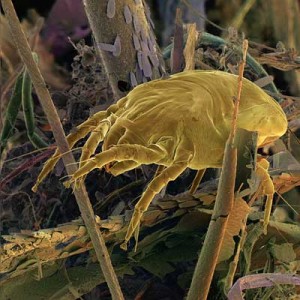 The most common cause of indoor allergy and asthma symptoms is dust mites, microscopic creatures that thrive in household dust, even in the cleanest homes. Dust mites are microscopic, eight-legged arachnids (not insects) 0.3mm in length. They are invisible to the human eye, so small they can crawl through the weave of bedding fabrics. Dust mites feed on tiny flakes of shed human skin cells. The average adult sheds about 2 pounds of skin per year. This will feed millions of dust mites.
The most common cause of indoor allergy and asthma symptoms is dust mites, microscopic creatures that thrive in household dust, even in the cleanest homes. Dust mites are microscopic, eight-legged arachnids (not insects) 0.3mm in length. They are invisible to the human eye, so small they can crawl through the weave of bedding fabrics. Dust mites feed on tiny flakes of shed human skin cells. The average adult sheds about 2 pounds of skin per year. This will feed millions of dust mites.
The dust mite is not what causes the problem. The problem lies with a protein found in the fecal matter called Der p1. The fecal matter is lighter than air and becomes airborne when disturbed by activity like fluffing pillows and tossing and turning during the night. The airborne particles are inhaled; the protein Der p1 breaks down the protective mucous lining of the eyes, nose, lungs and skin. The allergens enter the body and cause an overreaction of the human immune system. A thorough cleaning of all surfaces and textiles and following these tips can reduce dust mites and their fecal matter.
Control Temperature & Humidity
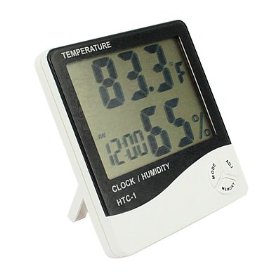 Maintain a comfortable temperature and relative humidity of 35% – 50 % If you can cut down on the amount of humidity, you can decrease mold growth and dust mite population. Air-conditioning often helps because it allows you to keep the windows closed on high-pollen days and keeps mold growth and dust mites to a minimum. A centralized heating and cooling system helps to maintain the same temperature and control humidity throughout the house. Keeping the house cool and dry helps reduce mold, dust mites, and cockroaches.
Maintain a comfortable temperature and relative humidity of 35% – 50 % If you can cut down on the amount of humidity, you can decrease mold growth and dust mite population. Air-conditioning often helps because it allows you to keep the windows closed on high-pollen days and keeps mold growth and dust mites to a minimum. A centralized heating and cooling system helps to maintain the same temperature and control humidity throughout the house. Keeping the house cool and dry helps reduce mold, dust mites, and cockroaches.
A basement can also be a source of high moisture which can result in mold. Use a dehumidifier to keep the level of moisture in the house to a relative humidity of 35-50%. If you discover water damage, have Referral professionally restore it to ensure mold doesn’t develop. Click here to learn water damage prevention tips.
On the flip side be sure not to lower the humidity to much. As the weather turns dry and the humidity is low static electrification due to walking across carpet is much more likely to occur and to cause an annoying or unpleasant shock. Today many carpets have conductive filaments or antistatic agents build into the carpet fibers to avoid this problem. But certain carpeting may not have these features and is thus prone to static buildup. If your carpet ‘bites back’ in dry weather it may be possible to obtain some relief by increasing the humidity in the affected room. Adding a humidifier can accomplish the goal of raising the humidity to 30-40%. As the humidity goes up, this lessens both the static charge and resultant shocks.
Also be sure your clothes dryer is vented to the outdoors. This will prevent odors and high humidity indoors that can cause allergic reactions.
Increase Ventilation
 If you have forced air heating and cooling systems, leave the fan switched to on at all times. This will continually circulate the air in your home through the air filters, removing airborne particulates.
If you have forced air heating and cooling systems, leave the fan switched to on at all times. This will continually circulate the air in your home through the air filters, removing airborne particulates.
Proper ventilation in certain areas of the home is essential for improving your indoor air quality. An everyday task like cooking can produce odors, water vapor, and other potential irritants like grease and smoke. Avoid using standard window fans for ventilation, because they allow pollen and outdoor mold spores to enter the house. Use exhaust fans in the kitchen and bathroom to remove moisture and indoor pollutants.
Improve Air Filtration
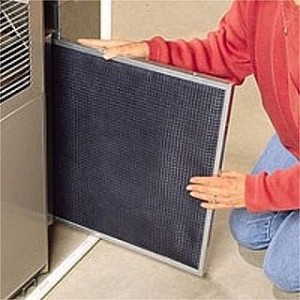 Be sure to regularly clean or replace your furnace’s air filter. A dirty or clogged air filter can decrease the circulation in the home and cause extra work for the furnace increasing utility bills. Also double check to make sure you replace it with the correct size filter.
Be sure to regularly clean or replace your furnace’s air filter. A dirty or clogged air filter can decrease the circulation in the home and cause extra work for the furnace increasing utility bills. Also double check to make sure you replace it with the correct size filter.
Consider using high-efficiency HEPA air filters. Although the EPA recommends air filtration, controlling the sources of allergy-causing pollution and ventilation are more important. Air filters are worth considering, but not as a solution to your asthma or allergy problems by themselves. In fact, research studies disagree on whether or not filters give much added relief in a clean and well-ventilated home. To improve your existing forced air heating/cooling system, consider installing an electrostatic filter. These filters, which work 3-4 times better than a standard foam filter, can be easily installed on your system to minimize small airborne particles that are potential allergens. An alternative to the electrostatic filter is the extended-surface air filter. This accordion-like filter, which is usually 2 to 6 inches thick, requires installation by a professional heating/cooling contractor. The extended-surface filter can last up to 2 years and can capture more airborne allergens than an electrostatic filter.
After taking these steps to remove obvious sources of indoor air pollution, consider purchasing an air cleaner to eliminate any airborne particles that remain. Air cleaners range in size, type, and efficiency. You can choose from an inexpensive, stand-alone, tabletop unit to more involved and expensive whole-house systems. The standard measure to rate the efficiency of an air cleaner is the Clean Air Delivery Rate (CADR), measured in cubic feet per minute. A higher CADR indicates greater ability for the air cleaner to return clean air to the room. Some models are designed with a higher CADR for one type of particle than another. Desktop models are generally too small to be effective, but a stand-alone, single-room High Efficiency Particulate Accumulator (HEPA) air cleaner can help filter out airborne particles like smoke, dust mite allergens, and pet allergens. Electronic air cleaners (also called electrostatic precipitators) are quite efficient, but they release a small amount of ozone while they’re running. In general, air cleaners do not remove irritating gases, such as radon, carbon monoxide, or formaldehyde. However, if they contain activated carbon or a similar material they can remove some types of gases.
Keep The House Clean
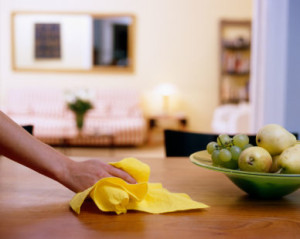 Since many irritants can be trapped in dust, keep your house dust-free. Once a week, use a damp cloth to wipe all flat surfaces. Be careful with the cleaning agents you use. Some scented or aerosol sprays and other cleaners can be irritants for people with asthma and allergies. To be on the safe side, use trigger sprays and a face mask, and increase ventilation while cleaning to minimize your exposure to irritating chemicals. While many allergens and irritants are suspended in household air, there are far more resting on surfaces like rugs, furniture and countertops. Keeping these areas clean is an important step in controlling your allergy and asthma triggers.
Since many irritants can be trapped in dust, keep your house dust-free. Once a week, use a damp cloth to wipe all flat surfaces. Be careful with the cleaning agents you use. Some scented or aerosol sprays and other cleaners can be irritants for people with asthma and allergies. To be on the safe side, use trigger sprays and a face mask, and increase ventilation while cleaning to minimize your exposure to irritating chemicals. While many allergens and irritants are suspended in household air, there are far more resting on surfaces like rugs, furniture and countertops. Keeping these areas clean is an important step in controlling your allergy and asthma triggers.
Don’t Forget Pets
 Dogs, cats and many other animals secrete fluids and shed dander that contains allergens. The allergens stick to the animal’s fur or feathers as well as carpet, furniture, bedding, clothing, and many other surfaces. Animal hair or fur is not an allergen itself, but can collect dander and harbor other allergens such as dust or pollen.
Dogs, cats and many other animals secrete fluids and shed dander that contains allergens. The allergens stick to the animal’s fur or feathers as well as carpet, furniture, bedding, clothing, and many other surfaces. Animal hair or fur is not an allergen itself, but can collect dander and harbor other allergens such as dust or pollen.
Animal allergens can be found everywhere including schools. Pet dander is even present in homes without pets because the dander is carried around on people’s clothing. The allergens get in the air with petting, grooming, or stirring of the air where the allergens have settled. Once airborne, the particles can stay suspended in the air for long periods of time.
The best treatment for allergies to animals is to avoid contact altogether, which may make it impossible for you to have pets with fur or feathers at home. If this is unacceptable, make sure you have a treatment plan for your asthma/allergies, keep pets out of the bedroom, keep the animals clean and follow the tips on this page.
- If you are irritated by pet urine odor click here to learn how Referral treats pet stains and urine odor.
- Click here to see the Humane Society’s Tips on how to live with allergies and pets.
- Download your guide to your allergies and your pet here.
5 Allergy Myths
Clean For Health
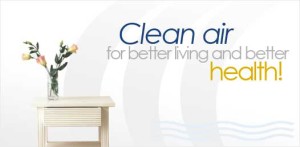 Carpet and upholstery fabric hide soil. Don’t just clean for appearance when the accumulation of soil becomes visible. Clean your carpet and all fabric surfaces in your home including mattresses, rugs and upholstered furniture. Thorough cleaning removes soil and pollutants to improve indoor air quality. Ensure you hire a company that uses the hot water extraction method, click here to learn what makes Referral’s cleaning technique unique. Referral can also apply an allergy relief treatment to the items we clean. If you are ready for a healthy home, call 260-483-4383. You can count on the professionals at Referral Cleaning & Restoration to make your home a healthy one with our cleaning services.
Carpet and upholstery fabric hide soil. Don’t just clean for appearance when the accumulation of soil becomes visible. Clean your carpet and all fabric surfaces in your home including mattresses, rugs and upholstered furniture. Thorough cleaning removes soil and pollutants to improve indoor air quality. Ensure you hire a company that uses the hot water extraction method, click here to learn what makes Referral’s cleaning technique unique. Referral can also apply an allergy relief treatment to the items we clean. If you are ready for a healthy home, call 260-483-4383. You can count on the professionals at Referral Cleaning & Restoration to make your home a healthy one with our cleaning services.
Don’t Rip Out Your Carpet & Replace It With Hard Surfaces
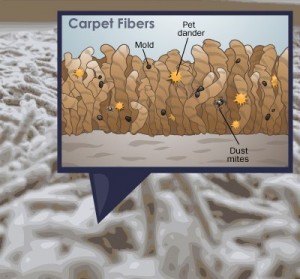 Carpeting and allergies are like best friends. Your carpet soaks up anything that touches it and won’t release it until it is thoroughly washed. You wouldn’t wear a t-shirt for a year without washing it, and carpet is fibrous material just like your clothes, it needs regular cleaning. Allergies are made better or worse depending on how old the carpet is, how thick it is, its quality and of course how often you clean it and with what method of cleaning. Carpet is the largest filter in a home. Carpet filters soils, gases, dust, spills and other pollutants. Most soils encountered are of microscopic size and are invisible to the naked eye. The smaller the particle size the easier it becomes airborne. Particles of one micron size can stay airborne for more than eight hours. These particles are respirable and can trigger allergic reactions. Carpet acts as a trap for airborne particles grounded through natural gravity until they can be safely removed during vacuuming. Professional Testing Labs studied the distribution of airborne dust associated with normal activities on hard and soft flooring surfaces. Their findings showed that walking on hard surfaces disturbed more particles because with each footstep the allergens become airborne and enter the breathing zone. In contrast, carpeted surfaces trapped more particles so that walking disturbed fewer particles. The result is less dust in the breathing zone over carpeted floors.It is rare for a person to be allergic to carpet, as carpet is usually made from the same sort of fabric types as your clothing. Of course if you know you get a horrible rash from that wool sweater you got from Aunt Barb last Christmas, make sure you talk to your carpeting specialist to avoid inadvertently buying a wool or wool-blended carpet. There are individuals who are allergic to certain types of carpet or the fumes that are released from new carpet, but they are a small percentage. The majority of people will have no trouble with the carpet in their home as long as it is well maintained. The EPA and carpet industry findings indicate that with proper ventilation of new carpet, carpet itself does not contribute negatively to indoor air quality.
Carpeting and allergies are like best friends. Your carpet soaks up anything that touches it and won’t release it until it is thoroughly washed. You wouldn’t wear a t-shirt for a year without washing it, and carpet is fibrous material just like your clothes, it needs regular cleaning. Allergies are made better or worse depending on how old the carpet is, how thick it is, its quality and of course how often you clean it and with what method of cleaning. Carpet is the largest filter in a home. Carpet filters soils, gases, dust, spills and other pollutants. Most soils encountered are of microscopic size and are invisible to the naked eye. The smaller the particle size the easier it becomes airborne. Particles of one micron size can stay airborne for more than eight hours. These particles are respirable and can trigger allergic reactions. Carpet acts as a trap for airborne particles grounded through natural gravity until they can be safely removed during vacuuming. Professional Testing Labs studied the distribution of airborne dust associated with normal activities on hard and soft flooring surfaces. Their findings showed that walking on hard surfaces disturbed more particles because with each footstep the allergens become airborne and enter the breathing zone. In contrast, carpeted surfaces trapped more particles so that walking disturbed fewer particles. The result is less dust in the breathing zone over carpeted floors.It is rare for a person to be allergic to carpet, as carpet is usually made from the same sort of fabric types as your clothing. Of course if you know you get a horrible rash from that wool sweater you got from Aunt Barb last Christmas, make sure you talk to your carpeting specialist to avoid inadvertently buying a wool or wool-blended carpet. There are individuals who are allergic to certain types of carpet or the fumes that are released from new carpet, but they are a small percentage. The majority of people will have no trouble with the carpet in their home as long as it is well maintained. The EPA and carpet industry findings indicate that with proper ventilation of new carpet, carpet itself does not contribute negatively to indoor air quality.
Many people think that carpets and allergies are a bad combination. Even some allergists will encourage their patients to remove carpeting in favor of hardwood or tile floors. However, carpets can actually help to reduce the allergens in your home by trapping them, as long as they are properly cleaned on a regular schedule. Health professionals sometimes recommend that allergy and asthma patients remove carpet from their homes. But those recommendations are generally based on faulty assumptions. In fact, clean, dry, well-maintained carpeting actually improves air quality.
According to Michael A. Berry, Ph.d., former Deputy Director for the EPA Environmental Criteria and Assessment Office, the single leading cause of poor indoor air quality in built environments today is poor maintenance. Carpet and upholstery must be cleaned to remove trapped contaminants before they overflow and are released back into the indoor air. For a healthier indoor environment, the Institute of Inspection, Cleaning and Restoration Certification (IICRC) recommends: Have your carpet cleaned professionally at least once a year by a certified firm to ensure the use of proper extraction procedures, to make certain that the carpet is not overwet and that the soil is not just redistributed, but removed. Learn more about the hot water extraction carpet cleaning method we use and learn why Referral is the best choice for allergy sufferers to keep your home clean and healthy.
Watch this video to learn more about carpet and allergies.
The following links provide articles and study results on the relationship between carpet and allergy symptoms.
- Click here to learn why The Carpet & Rug Institute say Carpet is a Healthy Choice.
- Click here to read “Carpet, Asthma and Allergies Myth or Reality?” by Mitchell W. Sauerhoff Ph.D.
- Click here to read Scientific Facts Dispel Carpet and Asthma Myths – National Floor Trends by Werner Braun
- Click here to read the press release from Shaw Flooring it suggests that effectively cleaned carpet can maintain indoor air quality, making it a viable choice for families impacted by allergies and asthma. Click here to read more about the study and its findings.
Contact An Indoor Air Quality Specialist
If after following the tips on this page you need more help in Fort Wayne area, contact Indoor Air Solutions at 260-478-2111 or visit www.indoorairsolutionsgroup.com